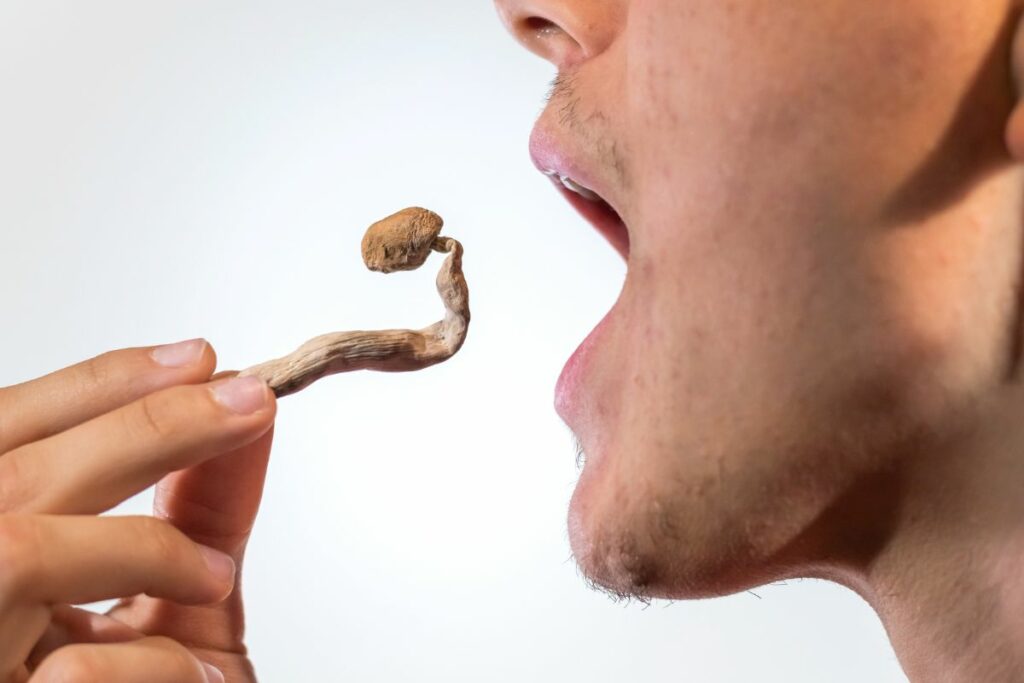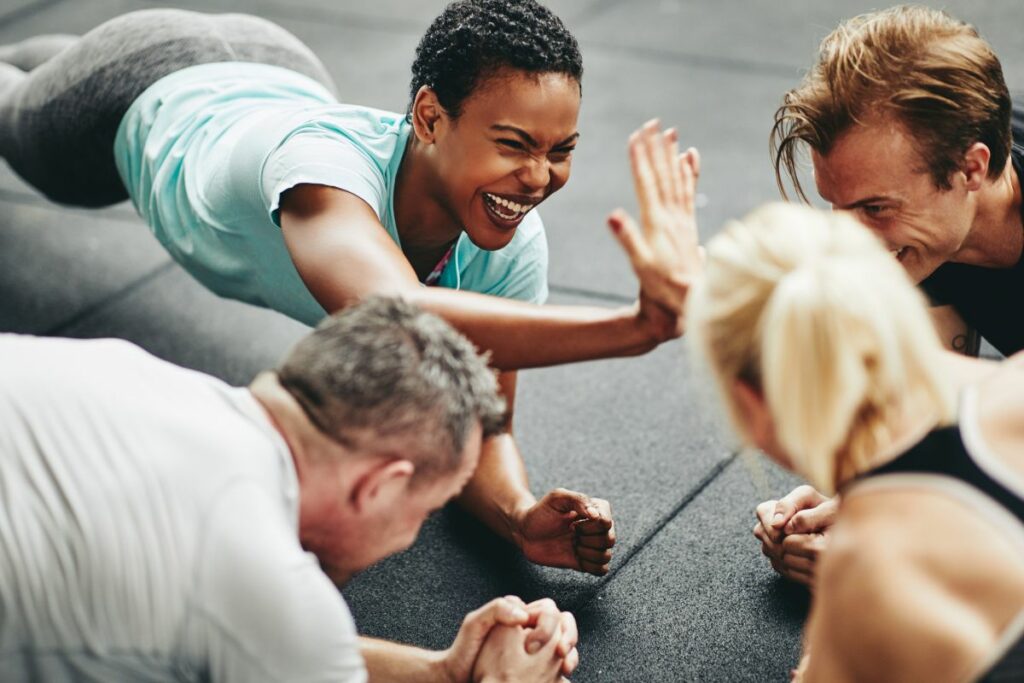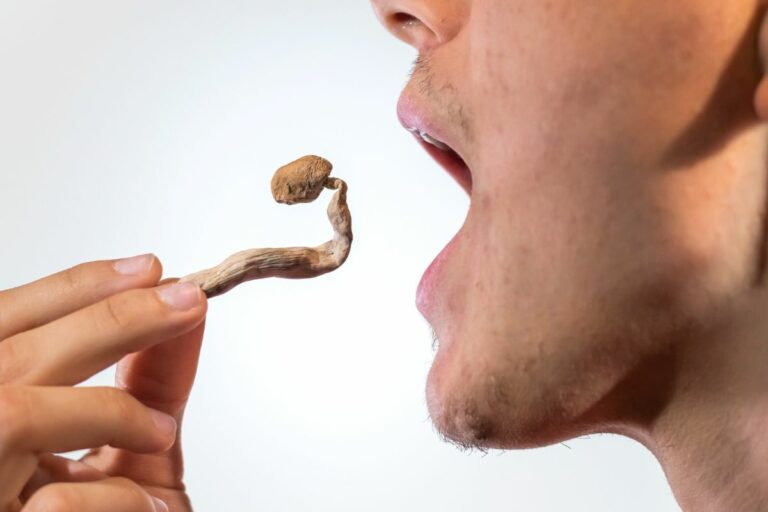Exploring the effects of psilocybin, commonly found in what are known as “magic mushrooms” or “shrooms,” has expanded beyond traditional recreational and spiritual domains. Engaging in physical exercise while under the influence of these psychedelics poses a curious question about the outcomes of such a practice.
Physical activities like working out require focus, coordination, and balance, and adding shrooms to the mix could potentially alter these capabilities. With their propensity to heighten sensory perception and emotional awareness, taking shrooms before exercise may influence your workout experience, possibly making it feel more intense or profound.
However, it’s important to approach the idea of working out on shrooms with caution. While some suggest that mild doses could lead to self-reflective or motivational insights, the unpredictable nature of psychedelics means your experience could vary greatly. Safety, both physical and psychological, should be your top concern when considering the combination of exercise and psilocybin.
Psychedelics and Physical Activity
Table of Contents
Exploring the interface between psychedelics like psilocybin, commonly found in magic mushrooms, and physical activity, can offer insights into how these substances may alter your exercise experience and performance.

| Psychedelic Substance | Potential Effects on Physical Activity |
|---|---|
| Psilocybin (Magic Mushrooms) | Varied reports; some users report enhanced sensory perception and appreciation of physical activities, while others may experience sedation or altered perception of time and space. |
| LSD (Lysergic Acid Diethylamide) | Enhanced sensory perception; altered time perception; potential stimulation; effects vary widely between individuals. Some users report increased physical energy, while others may experience sedation. |
| MDMA (3,4-Methylenedioxymethamphetamine) | Known for its empathogenic and stimulant effects; may lead to increased energy and motivation, but its primary effects are on mood and social interactions rather than physical activity. Increased heart rate is a common physiological effect. |
| DMT (Dimethyltryptamine) | Often associated with intense and short-lasting psychedelic experiences; limited evidence on its direct impact on physical activity, but it is more recognized for its profound visual and introspective effects. |
Understanding Psilocybin and Its Effects
Psilocybin is a naturally occurring psychedelic compound. Once ingested, your body converts psilocybin into psilocin, which then influences serotonin receptors in the brain. This can lead to altered perception, mood, and thought patterns. While some report enhanced mental clarity and creativity, others may experience a distorted sense of time and physical space, which could impact coordination and focus during physical activities.
Shrooms and Exercise: A General Overview
Considering the use of shrooms in the context of exercise, it’s crucial to acknowledge that psychedelics can induce a wide range of subjective experiences. On one hand, individuals report heightened sensory perception and a feeling of connection with their body, potentially making physical activity like yoga or running more engaging. On the other hand, the potential for reduced motor skills and altered judgment calls for caution, particularly with high-intensity or high-risk workouts.
Psychedelics and Athletic Performance
When it comes to athletic performance, the altered state of consciousness induced by psychedelics like psilocybin could both hinder and enhance your abilities. There is anecdotal evidence suggesting improvements in endurance and energy levels, potentially contributing to longer workout sessions. However, these substances can also impair your cardiovascular health and physical strength by distorting your ability to assess your body’s limits. Research is still in a nascent stage, but you can expect a complex interplay between psychedelics and physical health.
Safety Considerations
Before embarking on physical activities such as working out while on psilocybin mushrooms, commonly known as shrooms, it’s crucial to understand the potential risks and steps to ensure safety. Psychedelic substances can lead to varying experiences, which might affect your workout in unforeseen ways.

Risks of Working Out Under Influence
- Hallucinations: Shrooms are known for their psychedelic effects, including hallucinations. Working out under the influence may distort your perception of environment, balance, and coordination which can lead to accidents or injuries.
- Dose Management: Misjudging the dose could significantly alter your trip’s intensity, potentially creating an overwhelming or disorienting experience during exercise.
Ensuring Safe Psychedelic Experiences
- Safety First: If you choose to incorporate shrooms into your workout, have a sober spotter to monitor your safety. This person can help navigate any unexpected hallucinations or physical responses.
- Anti-inflammatory Precautions: While some research suggests anti-inflammatory properties of psychedelics, the relationship between shrooms and exercise-induced inflammation is not well understood. It’s wise to start with a low dose and closely observe how your body responds before and after workouts.
Psychedelic Microdosing and Fitness
Exploring the intersection of microdosing mushrooms and physical fitness unveils insights into potential mood enhancement, focus improvement, and a deepened sense of connection during your workout routine.

Microdosing Mushrooms for Athletic Endeavors
When you microdose psychedelics, particularly psilocybin mushrooms, you’re ingesting sub-hallucinogenic doses that could alter your athletic experience. Although comprehensive studies are less common, some anecdotal evidence suggests that microdosing could be linked to a subtle boost in stamina and endurance. It’s crucial to approach this with caution, as the research isn’t yet conclusive, and personal reactions to psychedelics can be unpredictable.
- Mental Health: Your mental well-being is central to your fitness. A mindset shift induced by microdosing could contribute to more consistent exercise habits.
- Creativity: While working out, you might find yourself devising new training methods or variations to existing exercises.
Impact on Mood, Focus, and Connection
Microdosing mushrooms may influence your serotonin levels, which in turn can affect mood and focus—key components in the quality of your fitness sessions.
- Mood: With serotonin being a critical neurotransmitter in mood regulation, microdosing could help uplift your spirits, potentially making your workouts more enjoyable.
- Focus: Enhanced focus can lead to greater mind-muscle connection, precise movements, and ultimately, a more effective exercise.
- Connection: You might discover a heightened sense of connection to your body, the environment, and the physical activity itself.
These are initial insights into psychedelic microdosing and fitness that point to the intricacies of how microdosing can potentially intertwine with your workout regimen.
The Mental Aspect of Psychedelics in Fitness
The inclusion of psychedelics, particularly psilocybin, in fitness routines has sparked interest in its potential mental health benefits and its role in stress and anxiety relief.
Potential for Improved Mental Health
Your journey with fitness often goes beyond physical well-being to encompass your mental health. Psilocybin, the psychoactive component in “magic mushrooms,” is being researched for its potential to foster significant shifts in mental states. This could lead to enhanced mindfulness, improved clarity, and a deeper sense of self-discovery. Important to note, these substances should be used responsibly and with awareness of legal and health implications.
The Role of Psychedelics in Stress and Anxiety Relief
When you’re grappling with anxiety or depression, managing stress becomes crucial in maintaining a balanced fitness regimen. Psychedelics like psilocybin may contribute to stress and anxiety relief, potentially providing you with a calming effect and the mental space to realign with your fitness goals. The practice of using these substances in a controlled, mindful environment can act similarly to meditation, creating a peaceful state that complements your physical activities.
Recovery and Well-Being
When you incorporate mushrooms with adaptogenic properties into your fitness regime, you may enhance your post-workout recovery and support your long-term health. These fungi offer potent anti-inflammatory benefits and could help reduce tension in your muscles.
Post-Workout Recovery
After a rigorous workout, your muscles need to repair and rebuild. Adaptogenic mushrooms, like cordyceps and reishi, can play a pivotal role in your recovery process. They have been observed to reduce inflammation and alleviate pain, which are common issues following intense exercise. Your recovery phase is crucial, as it allows your muscles to adapt and strengthen from the stress of working out. An example of such adaptogenic benefits can be found in materials like Super Powders: Adaptogenic Herbs and Mushrooms for Energy, Beauty, Mood, and Well-being, offering insights into how these substances can minimize discomfort post-exercise.
Long-Term Health Benefits
Over time, consistent exercise coupled with mushroom supplements could lead to enhanced overall well-being. Mushrooms such as chaga are rich in antioxidants which support your immune system. Managing oxidative stress with the help of functional mushrooms can contribute to better long-term health, as described in the study on functional foods derived from mushrooms. Consistent intake of these bioactive compounds during your fitness journey may improve not just your physical health, but also your mental well-being by reducing stress levels and enhancing mood.
Social and Cultural Perspectives
The integration of psychedelics, particularly magic mushrooms, into fitness and workout routines is not just a health matter; it’s also deeply rooted in societal attitudes and the evolving culture surrounding fitness and substance use.

Psychedelics in Modern Fitness Culture
You may have noticed a shift in the fitness culture where a holistic approach is often celebrated. Within this context, some individuals are incorporating psychedelics, aiming for a heightened state of consciousness that could potentially enhance their workout experience. Particularly, the use of magic mushrooms and LSD in small, sub-hallucinogenic doses, or “microdosing,” is gaining curious traction among fitness enthusiasts. Proponents suggest that such practices can lead to increased focus, creativity, and a sense of connection, contributing to more mindful and potentially more effective workouts. However, the social acceptance of psychedelics in gym settings varies widely, with legal and safety concerns often at the forefront of discussions.
- Substances
- LSD: Reported to boost creativity and energy.
- Magic mushrooms: May enhance connectedness with the body.
- Gym Environment
- Acceptance: Varied social perception.
- Legalities: Use is illegal in many regions.
Comparing Psychedelics with Other Substances
When you compare the use of psychedelics like LSD and magic mushrooms to other substances commonly utilized in fitness regimes, such as THC or cannabis, there are distinct differences in both societal perspectives and the intended effects. THC, the psychoactive compound in cannabis, is often associated with relaxation and pain relief, which can be counterproductive to workout goals that require high energy. Conversely, psychedelics are sought for their potential to induce a heightened state of awareness or euphoria, which may contribute to an enhanced perception of one’s capabilities during exercise. The context of use is critical, however, and the culture of fitness workouts tends to focus on legality, safety, and performance enhancement in line with accepted social norms.
- Primary Effects:
- THC/Cannabis: Relaxation, potential pain relief.
- Psychedelics: Heightened awareness, possible euphoria.
- Cultural Acceptance:
- Cannabis: Increasingly legalized and socially accepted.
- Psychedelics: Still controversial, less accepted in traditional fitness settings.
Conclusion
In exploring the intersection of psychedelics like mushrooms and fitness, you have tread into a complex field that intertwines mental and physical health. The insights from various discussions and research on psychedelics suggest that these substances can influence your perception and cognitive processes. When it comes to working out on shrooms, caution is paramount. Your safety should always be the top priority.
Consider the potential changes in sensory experience and judgment while on psychedelics and how these may affect fitness activities. It’s essential to understand the legalities and health implications. Engaging in physical exercise under the influence could increase the risk of injury due to altered coordination and perception.
From a mental health perspective, mushrooms have been considered for their therapeutic potential, yet they should not be seen as a universal solution to wellness. Your journey in fitness and health requires a balanced approach that prioritizes evidenced-based practices.
Before integrating unconventional methods into your routine, reflect on the established relationship between physical health and exercise. Recognize the value of a clear and focused mind during workouts, and note that introducing psychedelics into this equation introduces variables that are currently less understood and could carry risks.
Your well-being is multifaceted, involving both mental and physical components. As you navigate your fitness journey, base your choices on reliable information and prioritize your health above all.
Frequently Asked Questions
Before diving into the specifics, note that the relationship between psilocybin and exercise involves complex physiological and psychological effects. Ensure you are informed on the potential impacts and legalities involved.
What are the potential effects of exercising while under the influence of psilocybin?
Under the influence of psilocybin, your exercise experience may alter due to changes in perception, mood, and sense of time. Psilocybin can elicit feelings of euphoria, altered thinking processes, and a distorted sense of time, all of which might affect your workout.
Can physical performance be enhanced or hindered by taking psilocybin mushrooms before a workout?
Psilocybin may affect physical performance, since it can lead to altered mental states. While some report increased connection to their body, others may experience impairment. The substance has not been proven to enhance athletic performance reliably.
What safety concerns should be considered before engaging in physical activity while on psilocybin?
Safety should be a priority as psilocybin can impair judgment, reaction time, and motor coordination. Risks include potential injury from falls or misjudging abilities. Always err on the side of caution and avoid activities that require precise coordination or heavy machinery.
How does psilocybin ingestion impact coordination, reaction time, and overall motor functions during exercise?
Ingesting psilocybin can lead to impaired motor functions, slower reaction times, and uncoordinated movements. Such effects can make exercising challenging and potentially dangerous, particularly if the regimen requires balance and coordination.
Are there any benefits to combining psychedelic experiences with physical fitness routines?
While some proponents of psychedelic use claim benefits such as enhanced mindfulness and increased motivation, these claims lack substantial scientific backing. Experiences are subjective and can vary greatly among individuals.
What are the legal and ethical considerations of using psychedelics like psilocybin mushrooms in a fitness context?
Psilocybin is classified as a Schedule I controlled substance in many countries, including the United States, making its use illegal without a prescription or sanctioned study. Ethical considerations include the potential for impaired judgment and informed consent during physical activity.







